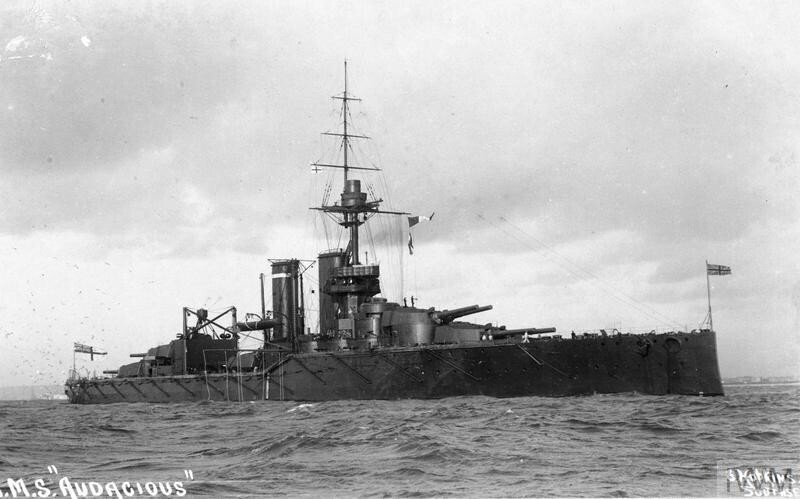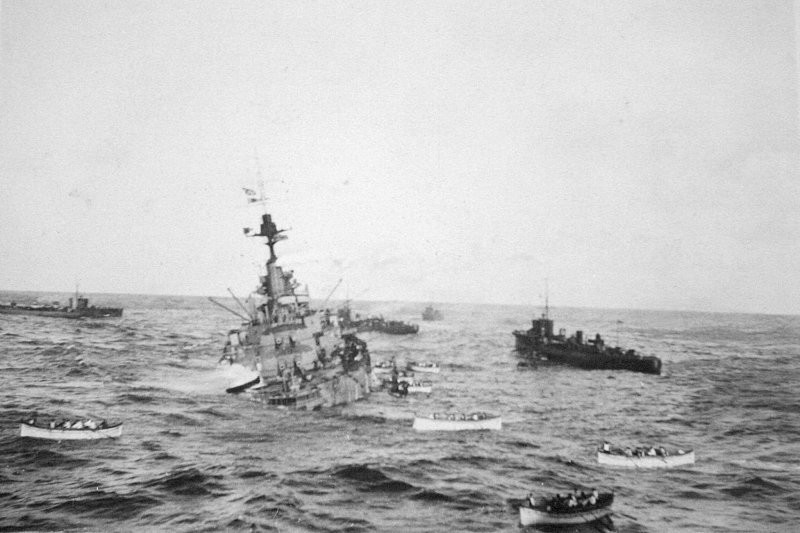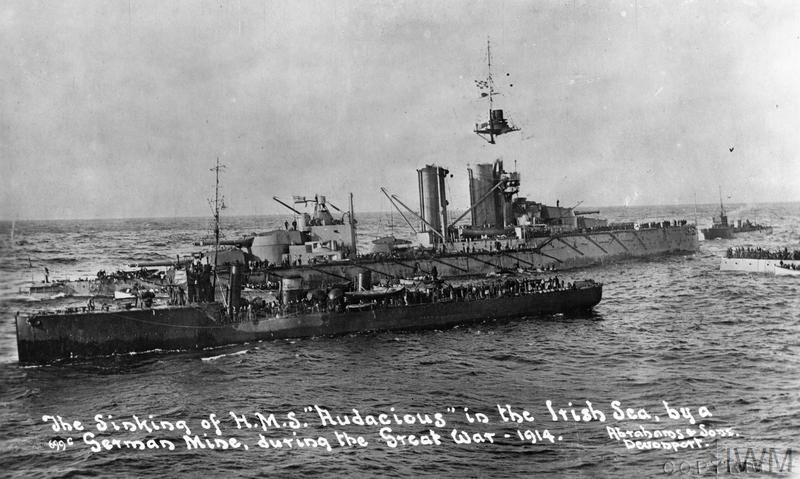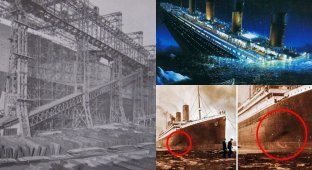Shame on the British Navy. The story of the death of the battleship Audacious (4 photos)
The death of a large ship is always a tragedy, accompanied by both cases of outstanding courage and cowardice. To protect against flooding, all modern ships have many systems in place to make death either impossible, or to delay it for a very long time, while the crew does everything to save their own ship. However, as always happens, even perfectly implemented ideas, when faced with reality, do not always work. 
HMS Audacious, 1914
Especially if there is an inexperienced crew of sailors and officers on board the ship, which is provided with everything for survival. And in this case, even staying in your native waters surrounded by an entire squadron of friendly ships will not help. As happened with the large warship of the most powerful fleet of the early 20th century - the battleship HMS Audacious.
The status of “the empire on which the sun never sets” placed very specific demands on Great Britain. Many colonies and extensive sea communications, covering almost the entire globe, required the maintenance of a large modern fleet. And if universal cruisers were enough to maintain order in the colonial possessions, then with the growing tension between the colonial empires and the First World War, which became almost inevitable, the largest fleet required the most powerful ships. England was the first country to launch the Dreadnought, a ship of a completely new concept, which immediately made all the fleets of other countries far behind, but to maintain the title of the first force in the sea, new ships of this class were also required. And one of them, designed to ensure superiority at sea, were the ships of the King George V series, designed as part of the shipbuilding program of 1910. A total of 4 ships were built under this project. HMS Audacious was laid down at the shipyard on 23 March 1911 and commissioned in August 1913.
Just in time, because the very next year the First World War broke out. And if on land active hostilities began from the first days, at sea everything developed slowly.
On October 27, 1914, Audacious, accompanied by several destroyers, was heading for firing practice off the coast of Ireland. And at 8:45 local time, he ran into a mine laid by the German auxiliary minelayer SS Berlin a few days earlier. Another interesting fact was that in this area a day earlier, a civilian ship was blown up by a mine, but the lack of direct communication between the civilian and military fleets led to the fact that the military sailors were not aware of what happened.
Moreover, according to some reports, Audacious was blown up by a mine due to the failure of the column, since initially all the ships followed a safe route in the minefield, without even knowing it.
The explosion occurred at a depth of 4.9 meters under the bottom of the battleship in the rear of the left engine room. At first, the British command believed that the ship was the victim of a submarine attack. All other battleships hastily left the area, leaving only the destroyers. The poorly trained crew was unable to immediately react to what happened: there were even cases of panic and abandonment of combat posts. This may have been what led to the rapid flooding of the engine room and several adjacent compartments of the Audacious. The ship suffered a list of 15 degrees, which was corrected to 9 degrees by counter-flooding almost an hour later.
It took about the same amount of time to find out that it was a mine and that there were no submarines here. And only after that they gave the order to all destroyers and cruisers present in the area to try to take Audacious in tow, and a signal for help was sent, which was answered by the sister ship of the notorious Titanic, Olympic. 
The cruiser HMS Liverpool and the destroyer HMS Fury attempt to tow Audacious. Photo from the Olympic
The commander of Audacious considered that he had every chance to save the sinking battleship and go 40 kilometers to the coast of Ireland to throw himself into shallow water. The ship remained underway and headed towards the coast at a speed of 9 knots, accompanied by destroyers. However, having traveled halfway, it received flooding in the central and right engine rooms, after which it stopped. The ship's commander ordered the extra crew to be removed from it, leaving only the minimum required crew. After which, first the cruiser HMS Liverpool, then the Olympic, and then the destroyer HMS Fury tried to take it in tow. Everything was useless - the battleship, which had taken on water, broke the towing cables over and over again, and by 19:15 its stern, which continued to gradually settle, disappeared under water. Only after this the commander gave the order to evacuate the remaining crew. 
Audacious crew loading onto lifeboats from Olympic
At 21.00 Audacious capsized, followed by an explosion, apparently in one of the ammunition magazines. A shrapnel killed a sergeant major from the cruiser Liverpool, which was located approximately 700 meters from the sinking battleship. He was the only one killed in this shipwreck.
Almost immediately, a commission was created to investigate what happened. At first, the main version was that Audacious ran into a mine that had fallen from one of the cruisers accompanying it, and only at the beginning of 1915 it became clear that the minefield was laid by a German ship. The investigation also established that the ship could have been saved, but the incorrect actions of the emergency teams, their general low training and malfunctions in the virtually brand-new ship collectively played a decisive role in its death. 
Evacuation of Audacious crew to destroyers
Audacious was the first battleship to be lost in the First World War. The loss of a new battleship not far from its coast in virtually internal waters could have seriously damaged the prestige of the Admiralty. Therefore, all information about his death was classified. Officially, Audacious was listed as undergoing combat service. Secrecy was taken to such a level that the entire crew wrote letters to their families from the supposedly still functioning battleship until the end of the war. This farce ended only in 1918, when the Admiralty thanked the British media for maintaining secrecy, for their cooperation and the successful completion of the enormous hoax.
In conclusion, it is worth saying that the first British battleship to die in the First World War turned out to be a real disgrace to the English fleet. To serve for just over a year and go down from one mine while in your home waters is the height of unprofessionalism. Perhaps this was precisely the reason for such a grandiose bluff on the part of the Admiralty - after all, if the command of the German fleet had known about such embarrassment, it would undoubtedly have acted more decisively against the British ships, realizing the extremely low level of training of the crews of its enemy.
























